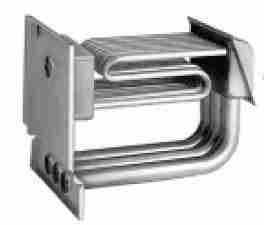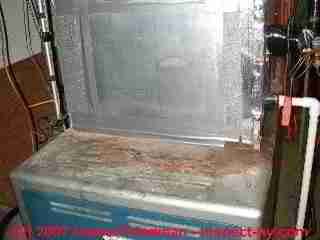 Furnace Heat Exchanger Life & Warranty Periods
Furnace Heat Exchanger Life & Warranty Periods
Guide to cause & prevention of furnace heat exchanger failures
- POST a QUESTION or COMMENT about furnace heat exchanger life expectancy & warranty periods
Furnace heat exchanger life:
In this article we discuss residential forced warm air furnace heat exchanger life in more detail, explaining the factors that impact the life of the heat exchanger, things you should do to maximize the life of the furnace heat exchanger, and similarly, things you should not do because they are likely to destroy your furnace before its time.
Here we also discuss provide: typical Residential Warm Air Heating Furnace Heat Exchanger Life. 13 Factors that Impact Residential Warm Air Heating Furnace Heat Exchanger Life. Should a Leaky Heat Exchanger be Repaired or Replaced? Table of Residential Heating Furnace Heat Exchanger Warranty Period.
InspectAPedia tolerates no conflicts of interest. We have no relationship with advertisers, products, or services discussed at this website.
- Daniel Friedman, Publisher/Editor/Author - See WHO ARE WE?
Furnace Heat Exchanger Life & Warranty Periods
Typical Residential Warm Air Heating Furnace Heat Exchanger Life
What is a Heat Exchanger?
Furnace heat exchangers transfer heat from the burning fuel (typically LP gas, natural gas, or heating oil) into building air. In most designs combustion gases pass from the combustion source (oil or gas flame and combustion chamber) through the heat exchanger's interior tubing to an exhaust point that vents gases through the heater's flue and chimney (sketch at left).
What happens if a heat exchanger leaks?
If a heat exchanger develops a leak (through rust perforation or by cracking due to metal fatigue) the heating system is most likely unsafe and needs repair or replacement. There are two principal reasons to talk about furnace heat exchanger life:
[Click to enlarge any image]
1. Safety: a leaky heat exchanger can be dangerous, risking carbon monoxide poisoning.
2. Cost: although it is possible to replace a leaky heat exchanger on many furnace models (not all), the labor cost and total cost investment in such a replacement in an older furnace is questionable enough that more often the ultimate cost is that of a new heating system.
A while back at HEAT EXCHANGER LEAK TEST reader Marlin asked "what is the normal life of natural gas furnace?" to which we replied "Just about the warranty period - manufacturers know their equipment well; warranty periods run from 10 years to lifetime." But this was a bit too glib. Here we provide the details about the causes of leaks in furnace heat exchangers and about furnace heat exchanger life expectancy.
Why do we care about leaky furnace heat exchangers? Furnace heat exchanger leaks may vary from trivial - even below the limits of detection, potentially fatal.
Watch out: Dangerous carbon monoxide gas leaks), potentially fatal, can be present intermittently depending on variations in heating system operation and building conditions.
Actual risk of CO poisoning varies even when there is a leak in a furnace heat exchanger depending on where the leak is, its size, the fuel used (gas vs. oil) and other factors that we discuss in taxing detail in a
companion article: HEAT EXCHANGER LEAK TEST.
13 Factors that Impact Residential Warm Air Heating Furnace Heat Exchanger Life
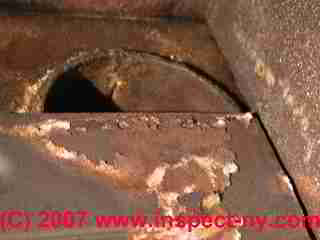
The top two most commonly-cited causes of leaks or failures of a forced warm air furnace heat exchanger are corrosion and metal fatigue.[21] To understand the actual causes of heat exchanger failures in a bit more detail is to know how to reduce the risk of this potentially dangerous and costly defect.
- Adjustment of the furnace burner (oil or gas), fuel to air mixture, or combustion air defects: any improper operation that causes the furnace burner to run too hot or too cool can damage the equipment in a variety of ways: thermal fatigue, condensation, production of corrosive agents.
- Airflow restrictions: anything that slows the flow of building air over the furnace's heat exchanger risks subjecting that component to high temperatures, increasing metal fatigue and shortening the unit's life.
Examples of airflow problems include dirty air filters, crushed, damaged air ducts, even improper original duct system layout and design. Beware of more subtle dirt that slows air flow such as a dirty squirrel cage blower fan - a component not normally included in furnace cleaning jobs. .
Greenheck points out that "Other than a corrosive environment, the airstream temperature rise is the largest factor driving heat exchanger material selection."[21] - Equipment specifications, construction quality and materials of the furnace such as grade and thickness of steel used
- Fan limit switch operation or any event that subjects the heat exchanger to abnormally high temperatures. For example, . if the fan limit switch is modified, damaged, or improperly adjusted then the heat exchanger can be subjected to a too-high operating temperature or it may be subjected to abnormally high temperatures if the blower fan shuts off too early at the end of a heating cycle.
- Furnace type: while a multi-stage furnace is probably more economical to operate, this design may subject the heat exchanger to higher temperature fluctuations. (This concern may be offset by improved manufacturer's warranty terms.)
- Gas pressure: in gas-fired furnaces, if gas pressure is too low the furnace heat exchanger may be subjected to excessive wet-time increasing corrosion in the unit. In oil fired furnaces improper burner adjustment may produce similar corrosive effects if soot combines with moisture.
- Heat exchanger materials: some warm air heaters such as some models of Rheem's gas furnaces using a stainless steel construction assert improved corrosion resistance and resistance to thermal fatigue [12] . Heat exchanger materials need to resist both corrosion and the effects of temperature cycling.
Commercial and indirect-fired heat exchangers in some commercial equipment offer alternatives to steel: aluminized steel (the aluminum corrodes to form an aluminum oxide resisting further corrosion), and stainless steel (chromium content resists corrosion by a mechanism similar to the aluminized steel product).[21]
As aluminized steel approaches 1100°F the aluminum begins scaling, exposing the steel. This temperature corresponds to an airstream temperature rise of approximately 70°F. However, at temperatures below the aluminized steel scaling point, the aluminized steel tends to outperform stainless steel with respect to heat stress cracking.
From this information, Greenheck recommends aluminized steel for temperature rises of 60ºF or less and stainless for temperature rises greater than 60ºF. For heating and ventilating applications and make-up air applications in mild climates where the airstream temperature rise is less than 60°F, aluminized steel will offer long furnace life and minimize the chance of heat exchanger stress cracking.
For make-up air applications in cold climates where airstream temperature rise exceeds 60°F, stainless steel is recommended. [21] - Installation: installation errors, even mechanical damage
- Maintenance level & frequency of the heating system; regular cleaning & maintenance extends equipment life. Oil burner soot forms corrosives when left in place in the off-use season. Failure to keep the heat exchanger clean subjects it to higher temperatures, potentially damaging this key component.
See HEAT EXCHANGER CLEANING.
If the furnace is capped by a cooling coil, maintenance must assure that its condensate is properly handled and the coil kept clean.
See CONDENSATE LEAKS - Moisture: exposure of the heat exchanger to moisture and thus rust: leaky humidifier, especially a humidifier or A/C drip pan located above the heat exchanger; humidifier or condensate leaks onto the heat exchanger, chimney leaks from condensate or actual water entry; a heat exchanger in a furnace located in a wet or damp basement or crawl space is at extra risk of rust damage & perforation.
The heat exchanger is also exposed to extra moisture simply from condensation if the system has long off-cycles during the heating season.
Corrosion occurs in the heat exchanger with the combination of water primarily with nitrogen and sulphur [21] to create sulfuric acid and other corrosives. - Operating duty cycle of the furnace
- Operating air speed: slower airflow around the heat exchanger may subject it to higher temperatures.
- Operating environment besides moisture listed above: e.g. a heater at an indoor pool exposed to chlorine means shorter life)
With all of these, and given that the manufacturers have a greater database of experience than the rest of us (and keep actual performance a trade secret), I figure we should quote anticipated furnace heat exchanger life as about that of its warranty period, excluding exceptional events. I will research for any updates to our list of scholarly articles on the topic and will include them in our article.
Moisture dripping onto the heat exchanger
is evident when we see an add-on air conditioner evaporator coil atop an older furnace, questionable or leaky condensate handling, rust stains atop the furnace, and similar clues.
Inspecting inside the furnace below the A-coil or evaporator or cooling coil one might see actual rust damage to the heat exchanger. Even if damage is not immediately visible, don't assume that a visual inspection of the heat exchanger is comprehensive. It's not.
At below left we illustrate a hole burned/rusted through the heat exchanger of an old oil-fired furnace.
At below right we were concerned about the burned fragments in the left side of the photo.
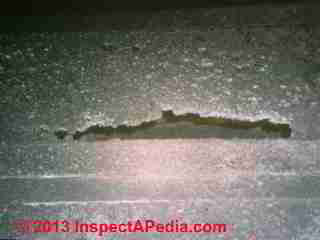
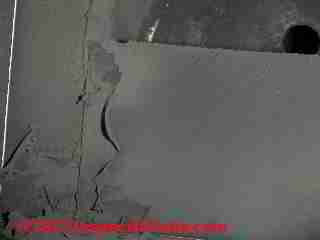
Our photo at below left shows variation in the gas flame of that furnace - a possible indicator of a heat exchanger leak. At below right we see what I call "exfoliating rust" (red arrow) that shows up in thick flakes or chunks - this is not superficial rust.
Our blue arrow points to a pile of this rust debris beneath the gas burner in a furnace that was installed in a damp area - the heat exchanger is suspect even before a thorough inspection.
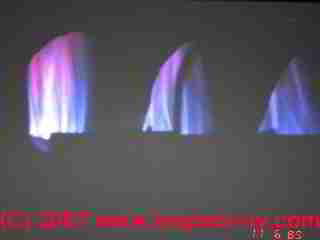
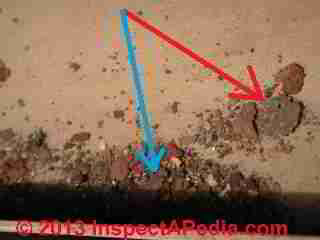
Our two photos below show a severely rusted gas furnace interior, and our red arrow (below right) points to a severe crack in the heat exchanger.
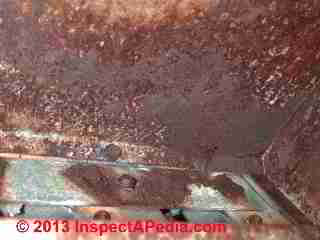

Should a Leaky Heat Exchanger be Repaired or Replaced?
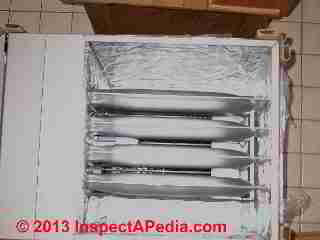
Just ask the equipment manufacturer. OK so everyone wants to sell you a new furnace or an expensive heat exchanger replacement. It's not just greed. No one wants to bear the risk of promising you that a repaired heat exchanger is safe.
Our photo at left shows the heat exchanger in a new gas furnace we installed in a Poughkeepsie NY Home.
We heard from folks describing repair attempts using high-temperature resistant epoxy, welding, and other low-cost solutions.
Any such repair is likely to void the manufacturer's warranty and each of them has a warning or three to keep in mind: epoxy may not bond reliably or may not withstand the furnace operating conditions;
MIG welding can avoid burning a big hole in the exchanger but if the welder is not an absolute expert the welding job may cause further metal fatigue and more heat exchanger cracking even larger than before; carbon monoxide gas is itself odorless and colorless; you may be depending entirely on carbon monoxide detectors for the life and safety of building occupants.
In fact Keith Prach, an expert on heat exchanger failures & testing notes that when a heat exchanger fails by cracking,
Cracks generally form at sharp corners and on or around welded seams. The stresses and forces at these locations make the metal more susceptible to crack initiation.[Prach later adds] Any area where the metal of the heat exchanger is configured with curves, ribs (concave or convex), indentations, dimples, or hot spots..., and weld seams are most likely to crack. [1]
Prach continues to describe the initial state of heat exchanger cracks as small, difficult to see, but growing ever larger as the heater goes through heating cycles. Adding welds, in my OPINION means adding stress points for future heat exchanger cracks.
OPINION: I would not try to repair a furnace heat exchanger.
If the furnace is generally in good condition and operates at a good efficiency but has suffered a cracked heat exchanger, one might consider a heat exchanger replacement when the cost of the total job is about half the cost of a new furnace and of course also if the furnace heat exchanger remains covered by the manufacturer's warranty.
On older furnaces and non-factory warranty heat exchanger replacements we're left with some questions: is the new heat exchanger warranted? Is the work proper, complete, safe? Were the same furnace heat exchanger leak tests performed after the repair as before?
List of Furnace Heat Exchanger Warranty Periods & Life Expectancies
Table of Residential Heating Furnace Heat Exchanger Warranty Periods |
||
| Manufacturer | Product | Warranty or Expected Life for Furnace Heat Exchanger |
| Composite opinion from various sources | Typical heat exchanger life - steel | 15-20 years [19] |
| Composite opinion, several sources | Typical heat exchanger life - cast iron | 40-50 years |
| Air-Ease Furnace Warranty | 10 years See the back page of the installation manual for the heater. Or contact the company with the model and serial number data from the data tag on your furnace. AirEase, 215 Metropolitan Drive, West Columbia, SC 29170 USA, Tel: |
|
| American Standard Furnace Warranty | Platinum ZV / SV / Gold ZM furnace (example) | Limited lifetime americanstandardair.com/ |
| Bryant Furnace Warranty | Gas, Model 987M | Lifetime Bryant.com 4/11/13 also see Carrier below. |
| Carrier Furnace Warranty | Oil furnace | Lifetime if properly registered in 90 days, else 20 years. |
| Gas, non-condensing | 20 years |
|
| Gas, condensing, tube & fin 2dary Heat Exchanger | Life or 20 years (model dependent); subsequent owner: 20 years. 90% Gas Furnaces Enhanced Warranty Policy [PDF] United Technologies Carrier Corporation 2014 Service Bulletin No. SMB 09-0024A (issued 6/8/09, revised 1/1/14) Carrier High Efficiency Gas Furnace Trade In Allowance Program 2016-2017 [PDF] |
|
| Small packaged products, aluminized steel heat exchanger | 20 or 15 years as above | |
| Small packaged products, stainless steel heat exchanger | Life or 20 years as above | |
Fedders Furnace Warranty Airwell-Fedders Warranty |
Packaged units, residential | 5-year limited ? Fedders now owned by a Chinese company, Singapore |
| Texas Furnace | Note: Airwell-Fedders may not honor Fedders HVAC warranties | |
| Goodman Furnace Warranty | Air Conditioners Gas Furnaces eg. GMVC95 |
Lifetime limited warranty on HVAC compressor & heat exchanger (10 year) Goodman Air Conditioning & Heating, 19001 Kermier Road, Waller, TX 77484 USA, Tel: 1-877-254-4729 Website: http://www.goodmanmfg.com/warranty-lookup |
| Greenheck Furnace Warranty | Indirect gas-fired furnaces, Commercial Units Centrifugal Ceiling & Cabinet Exhaust SP / CSP Energy Recovery Ventilators ERVs |
Lifetime limited warranty , furnaces Exhaust: 3 years from shipment Greenheck, P.O. Box 410 Schofield, WI 54476 USA, Tel: 715-359-6171 Website: www.greenheck.com |
| Heil Furnace Warranty |
Residential Gas Furnaces F9MAC, G9MAC, F9MVT, G9MVT, F9MAE, G9MAE, F9MVE, G9MVE F9MXT, G9MXT, F9MXE, G9MXE Heat Pumps, commercial & residential |
Furnaces: Lifetime or 20 years 1o year replacement warranty on high efficiency heat pumps Warranty transferred to subsequent owner = 20 years, all products HEIL RESIDENTIAL WARRANTIES [PDF] HEIL HEAT PUMP WARRANTY [PDF] List of warranties for current HEIL products: http://www.goheil.com/go/index.asp?t=109&s=622 Contact Heil Heating & Cooling Products: International Comfort Products 650 Heil Quaker Avenue P.O. Box 128 Lewisburg, Tennessee 37091 USA, Tel: (931) 2704100
|
| F8MVL, G8MVL, F8MTL, G8MTL F8MX(N/L), G8MX(N/L) |
20 years Website: heil-hvac.com 4/11/13 |
|
| International Comfort Products Warranty for HVAC Products | Furnace heat exchanger: 10 years HVAC Compressors: 5 years Functional components: 1 year |
INTERNATIONAL COMFORT HVAC WARRANTY [PDF] |
Janitrol Furnace Warranty Sold through Sears Roebuck. See Goodman Manufacturing |
Heating & Air Conditionin g | Limited warranty on heat exchanger: 20 years GMT GDT Gas Furnace: 5 year warranty on functional parts Extended warranty available JANITROL GMT GDT Gas Furnace Warranty Info [PDF] Website: www.janitrol.com obsolete. See GOODMAN HVAC MANUALS & ERROR CODES |
| Luxaire Furnace Warranty | All systems | Limited lifetime warranty luxaire.com 4/11/13 |
| Magic-Chef Furnace Warranty | ||
| Maytag Furnace Warranty | Gas furnace M1200-series | 5 years (if not registered) See GOODMAN HVAC MANUALS & ERROR CODES HVACr |
| Premier Furnace Warranty | [data needed] | |
| Rheem Furnace Warranty | Gas furnace heat exchanger | 20 years |
| Gas furnace, high efficiency economy | 20 years on Primary & Secondary heat exchangers | |
| Gas furnace, high efficiency & high efficiency 2-stage units | Limited lifetime | |
| Sears Homart Furnace Warranty | [data needed] | |
| Singer Furnace Warranty Singer American Furnace Warranty |
[data needed] | |
| Tappan Furnace Warranty | All furnaces | Limited lifetime tappan.net 4/11/13 |
| Trane Furnace Warranty | Gas furnaces | Limited lifetime trane.com 4/11/2013 |
| Oil Furnaces | Limited lifetime trane.com 4/11/2013 |
|
| Whirlpool Furnace Warranty | Gas Furnaces | Limited lifetime whirlpoolcomfort.com 4/11/13 |
| Gas Furnaces, stainless steel heat exchanger E.g. WGFM29/WGFD29 |
Limited lifetime furnace replacement whirlpoolcomfort.com 4/11/13 |
|
| York Furnace Warranty | Affinity or LX series furnaces | Limited lifetime york.com 4/11/2013 |
| Affinity or LX packaged units | 20-year warranty | |
| Latitude | 20-year warranty | |
| Latitude Model TG95 | Lifetime | |
Notes to the table above
Watch out: most furnace heat exchanger warranties as well as overall product warranty require that you register your heating system within a limited time period after its installation, typically within 60 or 90 days. If you fail to register a more limited warranty of shorter duration may apply.
Watch out: OPINION: product warranties including furnace heat exchanger warranties are sometimes more of a marketing tool than a reliable promise. The simple comparison of warranty terms such as number of years of warranty coverage does not reflect the ease or difficulty you may have actually making a successful warranty claim among various companies.
For a comparison of the environmental impact and life variations of different types of heating & cooling equipment see Shah (2008) [17] in our article end references.
We recommend that you never rely on visual inspection alone
to determine the safety of a furnace heat exchanger. Readers of this document should also
see CARBON MONOXIDE - CO
We include the text from historical articles on methods used for testing furnace heat exchangers for leaks, and the allowable or standards for heat exchanger cracks, holes, leaks, or carbon monoxide hazards from such leaks.
...
Reader Comments, Questions & Answers About The Article Above
Below you will find questions and answers previously posted on this page at its page bottom reader comment box.
Reader Q&A - also see RECOMMENDED ARTICLES & FAQs
On 2017-08-11 by (mod) American Standard heat exchanger failure report & warranty information
Barbara
If you can tell me the model and serial number of your American Standard heater (and the fuel it uses) I can probably find the warranty document.
I will also add links to American Standard heater and HVAC equipment warranty information in the article above - you may need to clear your browser cache or it may take 24 hours for the updated page to appear on your server.
Searching via several tools I did not find a specific report of any epidemic American Standard heat exchanger failures, though your installer may know something I couldn't find. Beware that some causes of heat exchanger failure can be due to an installation error. In such an instance, "all of them fail" may be true because "I install them all the same way" - perhaps.
Typical American Standard furnace heat exchanger warranties are 20 or 40 years. The company notes:
Note Regarding Heat Exchangers: If a heat exchanger fails because of a manufacturing defect within the sixth through twentieth year of the applicable warranty period, Company will, at its sole option, provide either a replacement heat exchanger without charge, or allow a credit in the amount of the then factory selling price of an equivalent heat exchanger toward the retail purchase price of a new heating unit.
If you didn't register your heater with the company when it was installed, a basic warranty may still apply.
Also see this American Standard HVAC warranty registration web page - or call for warranty registration: 1-855-260-2975.
https://www.americanstandardair.com/owner-support/warranty-and-registration.html
that includes this notice
If the product is not registered within 60 days of installation American Standard Heating & Air Conditioning’s Base Limited Warranty terms will apply.
If possible I'd also like to see a photo of the heater and also any photo or documentation about the nature, location, and size of the heat exchanger crack or leak. Use the page top or bottom CONTACT link.
Beware also that a cracked heat exchanger risks fatal carbon monoxide poisoning of building occupants - it's not something to ignore.
Tests for heat exchanger damage are not entirely reliable, and visual inspections can be difficult as usually not all parts of the heat exchanger are visible.
I've commented in this article series that depending on the size of a heat exchanger leak or crack and on where it is located, when the blower fan is running positive air pressure on the outside of the heat exchanger may blow air into the heat exchanger through the crack - so CO tests and smoke tests, depending on exactly when, where, and how they are conducted, can miss a cracked, unsafe heat exchanger.
Other readers take note: a common cause of dangerous cracking in furnace heat exchangers is overheating that in turn can be caused by reduced or blocked air-flow through the heat exchanger.
Causes of reduced heating system air flow
In turn, reduced airflow might be caused by any of a range of maintenance or other problems such as
- dirty air filter
- crimped or squashed heating ducts
- improperly- installed or sized ductwork for both supply and return air
- dirty squirrel cage blower fan
- improper voltage to the blower motor
- for pulley and belt driven blowers, a loose pulley or damaged belt
- a defective fan limit control
Of course there are other causes of heat exchanger damage and leaks including mechanical impact during transport or installation, and commonly, rust and corrosion from condensate or other water leaks or from equipment mis-adjustment.
On 2017-08-11 by Barbara Walker
We twice phoned and e-mailed the company that installed our American Standard heater 2 1/2 years ago. When they did not respond, we called another well known and reliable company to take a look at it and give it a tune up
. A crack in the Heat Exchanger was found and we were told that this is very common in that particular heater and that the installer knows this and continues to sell them. If we get them to replace the Heat Exchanger it can happen again. We don't know what to do. They never gave us a copy of the warranty. Any help would be appreciated. Thank you.
On 2017-05-24 by (mod) r direct vent heater
Right, Viking, assuming that your direct vent heater is the type that combines a combustion air INTAKE along with the exhaust venting out. (Some systems take combustion air from the interior).
If your system is return-air-starved, fixing that is very worthwhile.
On 2017-05-24 by AnonViking
Recombustion air: system is now direct vent, so this shouldn't be a problem, correct?
Thank you, will check search on HVAC return air improvement.
On 2017-05-24 by (mod) inadequate airflow or return air is a duct problem not a rust or heater problem
Got it.
But in my view inadequate airflow or return air is a duct problem not a rust or heater problem
We have suggestions about improving return air found by using the search box for HVAC RETURN AIR IMPROVEMENT
If the B-vent had severe condensation I'd also check that the chimney was properly sized and routed and that there is adequate combustion air.
On 2017-05-24 by AnonViking
No humidifier; run separate plug-in dehumidifier in summer. Concern is airflow back to furnace is not adequate.
Furnace is in N corner of basement. Had issue with galvanized sheet metal B-vent of previous furnace rotting out probably due to condensation in B-vent, so a direct vent furnace was installed to replace.
On 2017-05-24 by (mod) start by looking carefully to find the cause of the rusted heat exchanger
Viking
Good question, though I'm not sure of an authoritative answer to the choice you ask about. I would start by looking carefully to find the cause of the rusted heat exchanger.
If for example there is a humidifier installed over the furnace that could be destroying whatever equipment is below (by leaks onto the heat exchanger) - it would be really annoying to install an new furnace and A/C system and see that destroyed again by the same problem.
If you can get the heat exchanger replaced under warranty AND find and fix the leak that ruined it that might be most-economical.
On 2017-05-24 by AnonViking
Have Trane XR90 (90% efficiency) in 11/2006. It is installed in a 1990"s home with 6-8 inch circular flexible ducts between floors and 14" foam ducts out of furnace to main floor.
Since 2015, heat exchange has rusted, leaking in furnace. AC coils were installed in anticipation of AC, but finances and other events prevented compressor installation. Do I fix H/X under warranty and install AC with new coils OR install new multi-stage Trane 95% efficiency system + A/C? Concerned I will have same problems again with either solution.
On 2017-02-15 by marten
Modern times modern troubles. My daughter lives in a home built in 1932. Has an ancient HENDERSON CLIPPER fan forced furnace. All tested and good to go. Has been serviced regularly. Probably caste iron heat exchanger, built to last.
On 2015-04-14 by (mod) Often the labor cost plus ending up with a repaired older system loses in comparison with the swap in of a new furnace.
I agree Tony. Often the labor cost plus ending up with a repaired older system loses in comparison with the swap in of a new furnace.
On 2015-04-13 by Tony
Comparing Amana against Luxaire furnace:
Amana has lifetime "UNIT" replacement for heat exchanger failure
Luxaire has lifetime heat exchanger replacement
From a labor aspect, it seems it would be cheaper to go with Amana's full unit replacement than the labor cost to replace just the heat exchanger. Opinions?
On 2015-02-22 by (mod)
It may help to brain an independent expert inspectin, diagnosis, written report
On 2015-02-22 0 by Anonymous
I had a boiler installed in 2002 and in 2012 there was a problem with the boiler. i had a 10 yeaar warrenty that wasnt horned and was charged a substainal amount to repair and replace parts. I felt the company didnt honor there warrenty and stopped paying the. now Im in court. what shall i do?
On 2014-09-27 by Carole Y
Your article does not mention Lennox heat exchangers. We installed an Elite 12 Residential Packaged Gas/Electric unit. After the 10 year period the heat exchanger went out and we replaced it.
However it was replaced just 4 years ago. That does not seem very long ago. Can you help me by giving me any further information. We don't know whether to replace it or buy a new unit. We are retired and on social security for our income and its a very large investment for us to consider.
Thank you,
Carole Y
On 2014-04-18 by michelle
Danie. Thank you for that information. Will do some more homework.
On 2014-04-18 by (mod)
Hi Michelle, It's too bad about your furnace heat exchanger, though good that you learned about a potentially dangerous condition in time to avoid something worse!
I would not waste a SECOND arguing about this, going to court, suing, or anything else before having a more accurate diagnosis of just what's wrong with your furnace's heat exchanger, or to be more clear, to understand what siort of hole is present in the heat exchanger, where the hole is located, and most importantly why it occurred.
WHY? Because without simple, easy-to-understand factual evidence you'll waste time arguing while everybody points to others.
THEN we can have an idea who's responsible for the equipment failure that in turn will give you some guidance on how you want to proceed.
Some examples:
If the heat exchanger failed with a rust hole due to an improperly-installed humidifier that might be the installer's responsibility, though they'll blame you for not watching and maintaining the unit.
If the heat exchanger failed because the whole unit was dropped and banged and damaged during shipping or installation that would produce, probably, a crack of particular characteristics.
If the furnace heat exchanger failed due to overheating that may be due to an improperly installed, adjusted, or damaged fan limit switch - a switch problem that could have originated at the factory, at the installation, or over the life of the erquipment.
If the heat exchanger failed with a perforation or crack that occurred during normal operation on a properly installed and maintained machine, that may indeed be something that ought to be covered by product warranty.
In my OPINION unfotunately today too many warranties are more of a marketing tool used on the front end of selling equpment than a too, used to obtain customer loyalty by replacing a defective product (the manufacturer's warranty) or to maintain customer loyalty to a heating installer or service company (the installer's warranty that their work was correct).
Keep us posted.
Danie
On 2014-04-18 by michelle
my 5 yr old Williamsom 25000 seer oil furnace has a hole in the heat exchanger. Williamson tells me its the installer and the distributor I should go after. The installer has told me that he doesn't own any responsibility! I am out over $4,000. What say you about the lowly consumer? Lawyer or small claims court? Should I keep the whole furnace as evidence or take photo's? Need answers soon. No heat in Ct!
Question:
Could you tell me what the normal life expectancy of a home furnace heat exchanger is? Many thanks. - J.F. 3/11/2013
Reply:
Thanks for the question - it prompted us to expand our original furnace warranty information in the article above.
...
Continue reading at HEAT EXCHANGER LEAK TEST or select a topic from the closely-related articles below, or see the complete ARTICLE INDEX.
Or see
Or see these articles on
Furnace Heat Exchanger Leak Inspection & Testing
- AGE of HEATERS, BOILERS, FURNACES
- BACKDRAFTING HEATING EQUIPMENT
- CARBON MONOXIDE WARNINGS: HOME HEATERS
- DUCT & AIR HANDLER ODORS
- GAS MEASUREMENT INSTRUMENTS
- HEAT EXCHANGER CLEANING
- HEAT EXCHANGER LEAK TEST
- HEAT EXCHANGER LIFE & WARRANTY
- HEATING FURNACE INSPECTION GUIDE
- LIFE EXPECTANCY of AIR CONDITIONER or HEAT PUMP
- LIFE EXPECTANCY of FAN / WALL CONVECTOR
Suggested citation for this web page
HEAT EXCHANGER LIFE & WARRANTY at InspectApedia.com - online encyclopedia of building & environmental inspection, testing, diagnosis, repair, & problem prevention advice.
Or see this
INDEX to RELATED ARTICLES: ARTICLE INDEX to HEATING FURNACES
Or use the SEARCH BOX found below to Ask a Question or Search InspectApedia
Ask a Question or Search InspectApedia
Try the search box just below, or if you prefer, post a question or comment in the Comments box below and we will respond promptly.
Search the InspectApedia website
Note: appearance of your Comment below may be delayed: if your comment contains an image, photograph, web link, or text that looks to the software as if it might be a web link, your posting will appear after it has been approved by a moderator. Apologies for the delay.
Only one image can be added per comment but you can post as many comments, and therefore images, as you like.
You will not receive a notification when a response to your question has been posted.
Please bookmark this page to make it easy for you to check back for our response.
IF above you see "Comment Form is loading comments..." then COMMENT BOX - countable.ca / bawkbox.com IS NOT WORKING.
In any case you are welcome to send an email directly to us at InspectApedia.com at editor@inspectApedia.com
We'll reply to you directly. Please help us help you by noting, in your email, the URL of the InspectApedia page where you wanted to comment.
Citations & References
In addition to any citations in the article above, a full list is available on request.
- [1] Books on Furnace Heat Exchanger Inspection & Testing:
- Keith R Prach, Residential Furnace Heat Exchangers : History of Metal Failure and Behavior Inspection Techniques and Procedure [at Amazon.com], KRP Enterprises, 1993, ISBN-10: 0963742426
ISBN-13: 978-0963742421
You may also be able to purchase this book from its author: Keith Prach, K&P Enterprises, Inc., 1800 E. Lincoln Suite C-3, Fort Collins CO 80524 - Ellis Prach,Heat Exchanger Experts Residential Furnace Inspection Manual [at Amazon.com, may be out of print], Heat Exchanger Experts Residential Furnace Inspection Manual [at Amazon.com], Quoting: This full-color residential furnace inspection manual will broaden your understanding of how defects occur in furnace heat exchangers and will enable you to accurately assess the integrity of any furnace. You will be led through the steps to identify defects, according to the history of metal failure in a variety of commonly used residential furnaces, and taught the techniques required to conduct furnace heat exchanger evaluations. The Heat Exchanger Experts Manual will prove to be invaluable for seasoned technicians, novice technicians and everyone in between
- Keith R Prach, Residential Furnace Heat Exchangers : History of Metal Failure and Behavior Inspection Techniques and Procedure [at Amazon.com], KRP Enterprises, 1993, ISBN-10: 0963742426
ISBN-13: 978-0963742421
- [2] "Heat Exchanger Testing, Who's Right?" Dan Friedman, The ASHI Technical Journal, Vol. 2 No. 1, July1991. DJ Friedman (editor of InspectAPedia.com) served as a professional home inspector and forensic investigator of building failures from, 1986 to 2010. He previously operated a heating and cooling service and repair company and a residential construction and renovation firm.
- [3] "Case History: LP Gas Leak - Using the TIF 8800," Dan Friedman, The ASHI Technical Journal, Vol. 2 No. 1, July1991
- [4] "Choosing and Using a Carbon Monoxide CO Monitor," Dan Friedman, The ASHI Technical Journal, Vol. 2 No. 1, July1991
- [5] American Gas Association, Fundamentals of Gas Combustion, 7th printing, September 1985. Prepared by American Gas Association Laboratories for American Gas Association, 1515 Wilson Boulevard, Arlington, VA 22209 and Gas Appliance Manufacturers Association, Inc., 1901 North Fort Myer Drive, Arlington, VA 22209.
- [6] National Fuel Gas Code, NFPA 54 1988 and ANSI Z223.1 1988, available from AGA at the address above, or from the National Fire Protection Association, Batterymarch Park, Quincy MA 02269
- [7]NFPA and AGA, National Fuel Gas Code Handbook, Z223.2, same source as above
- [8] "Residential Gas Furnace Heat Exchanger Testing", Douglas DeWerth, P.E. American Gas Association (AGA) Laboratories under SAM number 630-92 9/86. , Refrigeration Service Engineer’s Society’s Service Application Manual (SAM)" The manual outlines and explains the many test methods that are used and have been used to inspect and test heat exchangers. This manual also goes into detail about the test equipment used in the 3 step method that the AGA developed. RSES members can view the SAM minus the photographs and diagrams at http://www.rses.org. If you are not a member or want to purchase a complete copy call RSES (800)297-5660 for availability and cost.
- [9] Furnace Heat Exchanger Leak Test, American Gas Association .
- Step 1 Visual inspection.
- Step 2 Burner flame deviation test.
- Step 3 injecting a nitrogen/methane gas mixture into the burner chamber. The heat exchanger outlet of the heat exchanger is plugged and a combustible gas detector is used to check for gas leakage on the exterior of the heat exchanger. A detailed fact sheet on the AGA test procedure is of the heat exchanger.
- Source: http://www.aga.org/NR/rdonlyres/A156C36A-9324-4978-91B4-E78DB63DAD7D/0/8612FURNHEATEXCHNGLEAKTEST.pdf
- [13] Hwa, C. S. "Mathematical formulation and optimization of heat exchanger networks using separable programming." In AIChE-IChemE Symposium Series, vol. 4, pp. 101-106. 1965.
- [14] Kreider, Jan F., Peter Curtiss, and Ari Rabl. Heating and cooling of buildings. McGraw-Hill, 2002.
- [15] Kuppan, T. Heat exchanger design handbook. Vol. 126. CRC Press, 2000.
- [16] Abd El-Baky, Mostafa A., and Mousa M. Mohamed. "Heat pipe heat exchanger for heat recovery in air conditioning." Applied Thermal Engineering 27, no. 4 (2007): 795-801.
- [17] Shah, Viral P., David Col Debella, and Robert J. Ries. "Life cycle assessment of residential heating and cooling systems in four regions in the United States." Energy and buildings 40, no. 4 (2008): 503-513.
Abstract Heating and cooling systems consume the most energy and are the largest source of emissions in the entire life cycle of a house. This study compares the life cycle impacts of three residential heating and cooling systems—warm-air furnace and air-conditioner, hot water boiler and air-conditioner, and air–air heat pump over a 35-year study period. Simulation and life cycle assessment studies of the systems at four locations in the United States, namely Minnesota, Oregon, Pennsylvania and Texas determine the effect of regional variations in climate, energy mix, and the standard building characteristics on the systems’ environmental impacts. In Minnesota, Pennsylvania, and Texas, the heat pump has the highest impacts whereas in Oregon the heat pump has the lowest impacts. A second scenario shows that substitution by high-efficiency equipment reduces the impacts of all systems but does not affect the order of relative performance by region. Another scenario examined the replacement of coal-generated electricity by renewable generation in regional grids. In order to reduce the impacts of the heat pump system to the lowest of the three systems, renewable sources would have to replace 42% of electricity generation in Minnesota, 15% in Pennsylvania, and 38% in Texas. - [18]
Nishio, Gunji, Susumu Kitani, and Kazuhiro Takahashi. "Thermophoretic deposition of aerosol particles in a heat-exchanger pipe." Industrial & Engineering Chemistry Process Design and Development 13, no. 4 (1974): 408-415.
This article discusses the deposition of airborne particles and their impact on heat exchanger life and brittilization of the heat exchanger metal. - [19] Estimates of furnace heat exchanger life:
- High Performance Heating & Air, http://hphaa.com/picpages/101/heaterlife.htm, retrievedf 4/11/2013 10, 15, 20, 30 years, various reasons.
- HouseRepairTalk, "Life Expectancy for furnace?", houserepairtalk.com/f8/life-expectancy-furnace-9713/ retrieved 4/11/2013 - 15-20 years;
- Greg R. Wayman, "A Cracked Heat Exchanger is Nothing to Ignore", Home Tips, (Mr. Wayman is a home inspetor and a NAHI member), Website: F2Rinc.com, Tel: 402-3309-1701, 15 years, retrievedf 4/11/2013
- [20] US EPA, Steps to Reduce Exposure to Carbon Monoxide, website: http://www.epa.gov/iaq/co.html#Steps to Reduce Exposure to Carbon Monoxide
- [21] Greenheck, "Indirect Gas-Fired Technical Guide - Technical Guide: Heat Exchanger Material Selection", Greenheck Corporation, PO Box 410, Schofield WI 54476, Tel: 715-359-6171, Website: greenheck.com (2012), retrieved 4/11/2013, copy on file as IndirectGasFiredTechGuide_catalog.pdf
- American Gas Association, Fundamentals of Gas Combustion, 7th printing, September 1985. Prepared by American Gas Association Laboratories for American Gas Association, 1515 Wilson Boulevard, Arlington, VA 22209 and Gas Appliance Manufacturers Association, Inc., 1901 North Fort Myer Drive, Arlington, VA 22209.
- National Fuel Gas Code, NFPA 54 1988 and ANSI Z223.1 1988, available from AGA at the address above, or from the National Fire Protection Association, Batterymarch Park, Quincy MA 02269
- NFPA and AGA, National Fuel Gas Code Handbook, Z223.2, same source as above.
- DJ Friedman (editor of InspectAPedia.com) served as a professional home inspector and forensic investigator of building failures from, 1986 to 2010. He previously operated a heating and cooling service and repair company and a residential construction and renovation firm.
- Sensidyne Corp. 12345 Starkey Rd. Suite E, Largo, FL 33453 813/530-3602. Sensidyne does not sell retail. Their equipment is marketed by Industrial Products Company, 21 Cabot Boulevard, Langhorne, PA 19047 800-523-3944 or in PA 800-562-3305. This distributor also can supply GasTec colorimetric tubes used with the Sensidyne calibrated pump.
- TIF Instruments,Inc., 9101 NW 7th Avenue, Miami, FL 33150. Some ASHI Members operate inspection equipment companies and offer varieties of gas detection equipment:
- Draeger equipment is marketed to home inspectors by Kirsopp Home Inspections Inc., Belleville, IL 618-397-3057.
- Our recommended books about building & mechanical systems design, inspection, problem diagnosis, and repair, and about indoor environment and IAQ testing, diagnosis, and cleanup are at the InspectAPedia Bookstore. Also see our Book Reviews - InspectAPedia.
- In addition to citations & references found in this article, see the research citations given at the end of the related articles found at our suggested
CONTINUE READING or RECOMMENDED ARTICLES.
- Carson, Dunlop & Associates Ltd., 120 Carlton Street Suite 407, Toronto ON M5A 4K2. Tel: (416) 964-9415 1-800-268-7070 Email: info@carsondunlop.com. Alan Carson is a past president of ASHI, the American Society of Home Inspectors.
Thanks to Alan Carson and Bob Dunlop, for permission for InspectAPedia to use text excerpts from The HOME REFERENCE BOOK - the Encyclopedia of Homes and to use illustrations from The ILLUSTRATED HOME .
Carson Dunlop Associates provides extensive home inspection education and report writing material. In gratitude we provide links to tsome Carson Dunlop Associates products and services.


